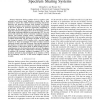Free Online Productivity Tools
i2Speak
i2Symbol
i2OCR
iTex2Img
iWeb2Print
iWeb2Shot
i2Type
iPdf2Split
iPdf2Merge
i2Bopomofo
i2Arabic
i2Style
i2Image
i2PDF
iLatex2Rtf
Sci2ools
INFOCOM
2011
IEEE
2011
IEEE
Transport throughput of secondary networks in spectrum sharing systems
—Spectrum sharing systems such as cognitive radio networks have drawn much attention recently due to their potential to resolve the conflict between increasing demand for spectrum and spectrum shortage. Such systems are typically composed of primary and secondary networks; the configuration of the latter depends on spectrum opportunity unexploited in the former. In this paper we explore the characteristics of the single hop transport throughput (STT) of the secondary network with outage constraints imposed on both networks. STT is a new metric that inherits the merits of both the traditional transport capacity and another popular metric, transmission capacity, incorporating transmission distance and outage probability into a uniform framework. We first derive the limit of STT, single hop transport capacity (STC), together with a practical upper bound for it. Then we investigate STT with secondary receivers randomly located in the field of interest. Three models regarding the sele...
| Added | 21 Aug 2011 |
| Updated | 21 Aug 2011 |
| Type | Journal |
| Year | 2011 |
| Where | INFOCOM |
| Authors | Chengzhi Li, Huaiyu Dai |
Comments (0)

